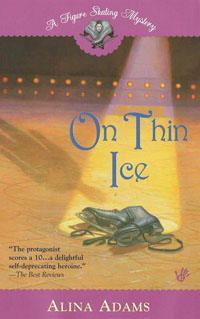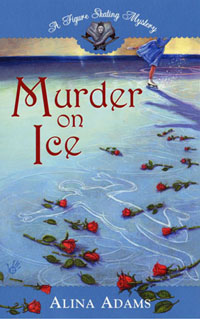LIGHTS, CAMERA, AXEL (PART #7)
There are those who claim that controversy is good for skating. Didn't the Tonya Harding/Nancy Kerrigan saga in 1994 trigger the current boom of interest in the sport?
Skating Director Meg Streeter believes that it wasn't the incident itself that did the trick, but the fact that television covered it. "If a TV camera had not been there to see Nancy's reaction -- it made very powerful television which people will remember for a long time -- if we had only heard about the attack and never seen it, I don't think it ever would have been quite the event it became. (Nancy) sitting on the ground, saying 'why?' made people want to stop, look, listen, and then want to follow (the story). In following it, they then got hooked on skating. People who'd never watched skating began watching. The nice thing is they stayed with it over the course of the next four years. Ironically, skating benefitted from a criminal act. But, had television not been there to bring it to people, we would not have had the increased viewership."
That increased viewership, however, did not, like most conjectured, lead to the increase of skating coverage that erupted on television almost immediately afterwards.
Jirina Ribbens, former Vice-President of Candid Productions, the creator and one-time producer of the "World Professional Championship" contends, "The popularity of skating at the 1994 Games made it interesting for TV, but it's not what caused the boom. What caused the boom was extra programming."
In 1994, CBS had just lost football. They needed to fill that programming time with something. That same year, USFSA president Claire Ferguson and Executive Director Jerry Lace wrote, "This glut of skating stems from... CBS scrambling to fill (a) void. Skating became a favorite filler because of the potential ratings."
Agrees Ribbens, "The boys in sports would have never thought of skating if it hadn't gotten such high ratings at the Olympics, and it was cheap, comparatively speaking."
What made figure skating so cheap for CBS to acquire was the sports-promotion company Jefferson Pilot, which owned quite a few of their affiliate stations, buying time for made-for-TV programs like "Ice Wars" and "Too Hot to Skate." (The company first went into the skating business in 1991, because Katarina Witt was then one of their clients, and they wanted a venue to showcase her). Though, in 1996, executive Mike Burg swore they wouldn't create an event "just for the sake of doing it," six new skating shows soon popped up on the small screen.
Streeter, however, is quick to add that it wasn't just CBS, because of its lack of alternate programming, that increased their skating coverage at the end of the last century. "It was all the networks. When UPN decided to put on their first live broadcast ever, it was a skating event, the U.S. Open. The USA network had three or four skating shows on. Turner had a quota of skating shows they wanted to get on the air. So, it wasn't just CBS putting on skating to replace football." NBC broadcast the World Professional Championships among many other pro events, and FOX had most of the Champions' Series, and its Final.
Stresses Streeter, "(In the 1990s) every network, and all the cable networks went out of their way to seek out skating shows."
So where did it all go wrong?
To Be Continued....
Skating Director Meg Streeter believes that it wasn't the incident itself that did the trick, but the fact that television covered it. "If a TV camera had not been there to see Nancy's reaction -- it made very powerful television which people will remember for a long time -- if we had only heard about the attack and never seen it, I don't think it ever would have been quite the event it became. (Nancy) sitting on the ground, saying 'why?' made people want to stop, look, listen, and then want to follow (the story). In following it, they then got hooked on skating. People who'd never watched skating began watching. The nice thing is they stayed with it over the course of the next four years. Ironically, skating benefitted from a criminal act. But, had television not been there to bring it to people, we would not have had the increased viewership."
That increased viewership, however, did not, like most conjectured, lead to the increase of skating coverage that erupted on television almost immediately afterwards.
Jirina Ribbens, former Vice-President of Candid Productions, the creator and one-time producer of the "World Professional Championship" contends, "The popularity of skating at the 1994 Games made it interesting for TV, but it's not what caused the boom. What caused the boom was extra programming."
In 1994, CBS had just lost football. They needed to fill that programming time with something. That same year, USFSA president Claire Ferguson and Executive Director Jerry Lace wrote, "This glut of skating stems from... CBS scrambling to fill (a) void. Skating became a favorite filler because of the potential ratings."
Agrees Ribbens, "The boys in sports would have never thought of skating if it hadn't gotten such high ratings at the Olympics, and it was cheap, comparatively speaking."
What made figure skating so cheap for CBS to acquire was the sports-promotion company Jefferson Pilot, which owned quite a few of their affiliate stations, buying time for made-for-TV programs like "Ice Wars" and "Too Hot to Skate." (The company first went into the skating business in 1991, because Katarina Witt was then one of their clients, and they wanted a venue to showcase her). Though, in 1996, executive Mike Burg swore they wouldn't create an event "just for the sake of doing it," six new skating shows soon popped up on the small screen.
Streeter, however, is quick to add that it wasn't just CBS, because of its lack of alternate programming, that increased their skating coverage at the end of the last century. "It was all the networks. When UPN decided to put on their first live broadcast ever, it was a skating event, the U.S. Open. The USA network had three or four skating shows on. Turner had a quota of skating shows they wanted to get on the air. So, it wasn't just CBS putting on skating to replace football." NBC broadcast the World Professional Championships among many other pro events, and FOX had most of the Champions' Series, and its Final.
Stresses Streeter, "(In the 1990s) every network, and all the cable networks went out of their way to seek out skating shows."
So where did it all go wrong?
To Be Continued....






0 Comments:
Post a Comment
Links to this post:
Create a Link
<< Home